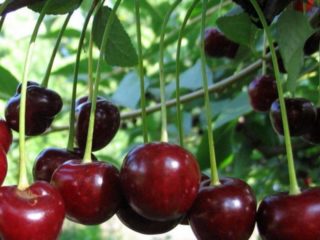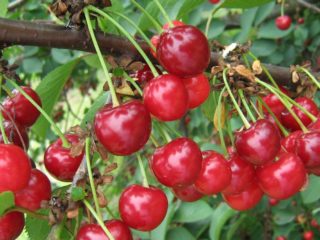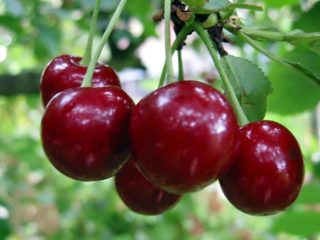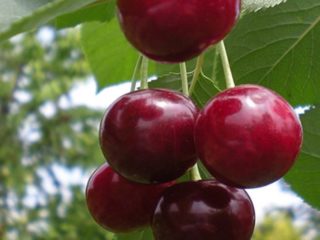Content
Preparing cherries for winter is the most important stage in growing a fruit crop. The yield in the next year depends on how well the cherry will survive the winter, therefore, you need to approach the processing and insulation issues very carefully.
How to care for cherries after harvest
Preparation for winter for cherries begins at the end of summer, after the harvest has been harvested. A fruit tree that has given up berries gradually begins to move into a dormant state. During this period, the gardener is required to carry out all measures to prepare for the winter, namely:
- watering before the onset of cold weather to store moisture;
- top dressing to strengthen the vitality of the tree;
- sanitary and formative pruning;
- loosening the soil before winter;
- warming the plant before the cold weather.

Autumn care of the fruit tree begins in August
Caring for felt cherries after harvest
Preparing felt cherries for winter generally does not differ much from standard autumn care. After harvesting, you must:
- how to cleanse the ground in the near-trunk circle - remove all rotten fruits and crumbling leaves, small branches from the ground;
- take out the garbage from the site and burn it, pests and fungal spores can winter in plant residues, so it is imperative to destroy the garbage;
- thin out the crown of the plant, remove shoots and lower branches, as well as shoots that make the crown too thick;
- how to loosen and mulch the soil near the trunk.
Caring for cherries after harvesting also requires watering abundantly, feeding with minerals and insulating the fruit plant for the winter.
Features of cherry care in autumn, depending on the age of the trees
The general rules for caring for cherries in autumn and preparing for winter are the same for all plants, regardless of age. However, old and young trees have their own characteristics that must be taken into account in autumn care:
- Young plants under the age of 3 years do not need to be fed with minerals before the onset of winter. Since a plant planted recently is not yet bearing fruit, it consumes less nutrients, up to 3 years it has enough minerals embedded in the ground during planting.
- Old cherries are fed annually. An adult plant takes a lot of energy to bear fruit, therefore, during the warm season, it manages to exhaust its supply of nutrients.
- Autumn pruning for young trees must be done with great care. Since they are still very small in size, too strong a haircut can lead to their death.
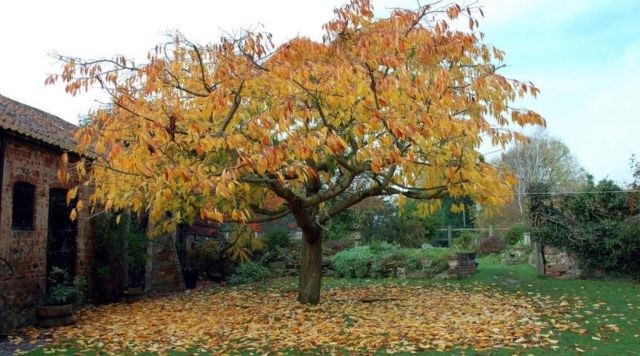
Older trees are more resistant to cold weather
Caring for young cherries in the fall includes a more thorough covering, young trees are more susceptible to freezing. Usually they are not only mulched abundantly, but branches are also tied up, and also covered with insulating material. Old trees tolerate cold better, and for them, in preparation for winter, it is most important to warm the roots and cover the trunk with spruce branches.
How to care for cherries in the fall for a good harvest
It is necessary to take care of the next year's harvest in the fall. To strengthen and heal trees, a number of procedures are carried out, each of which should be considered more carefully.
Watering and loosening the soil
Cherry care in August and September involves abundant watering. Dry soil freezes harder and deeper than wet soil, so watering additionally protects cherry roots from frost.
In preparation for winter, it is necessary to shed soil under the plant to a depth of 1-1.5 m.The frequency of watering is determined based on the weather conditions - if it is rainy autumn, it is enough to water the tree 1-2 times, if there is little rain in September, the number of watering needs to be increased ...
A one-time watering volume is 5-6 buckets of water for an adult tree. You can also dig a small groove around the trunk and put a hose in it for half an hour; when using this method, the soil will also be well saturated with moisture.
To determine how much the plant needs feeding, you can dig a hole about 60 cm deep near it.If the ground at the bottom of this hole is wet, then watering is minimal, if the soil is dry and crumbles, you need to moisten the soil more abundantly.
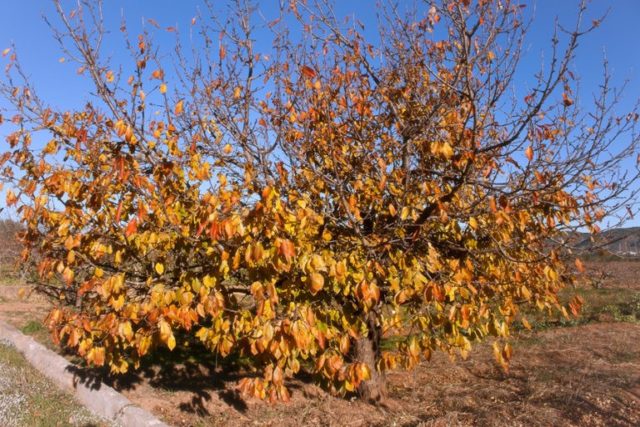
Autumn watering for a cherry tree is required
After the final watering, the soil must be mulched tightly - this will preserve moisture and at the same time provide additional insulation for the roots.
In preparation for winter, the earth under the trunk must be dug up. Digging is carried out to a depth of about 15 cm so as not to damage the roots of the tree. Before carrying out the procedure, the area is carefully cleaned, the fallen leaves and fruits are removed, the plant debris is raked up and burned.
Digging the soil not only provides good air and moisture access to the root system. Pests and spores of fungal diseases often hibernate in the ground; when the soil is loosened, they appear on the surface and quickly die with the onset of frost.
Top dressing
Autumn feeding before winter is carried out at the end of September or early October. Fertilizers applied in preparation for wintering ensure crop vigor and good growth next spring:
- Autumn feeding is usually carried out by the root method - fertilizers are applied to the soil during digging and watering, and not sprayed over the crown.
- Both mineral and organic fertilizers can be used in autumn. From organic matter, compost, humus and bird droppings are usually used, from minerals - phosphorus, calcium and potassium.
- Organic fertilizers can simultaneously serve as a mulch layer and insulation. For adult trees, about 50 kg of humus or compost are scattered in the near-trunk circle, for young cherries they take about 30 kg.
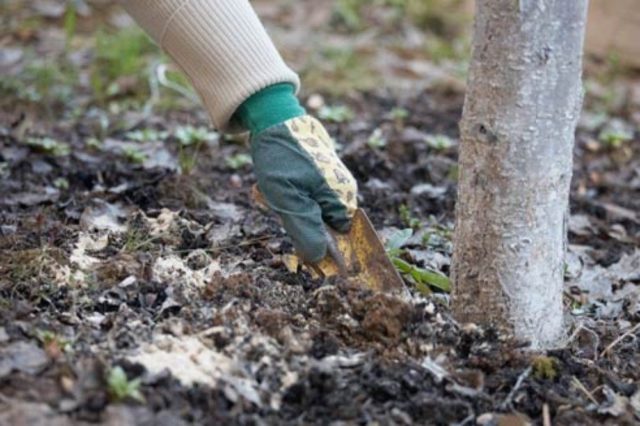
For the winter, both organic and mineral dressings are introduced into the soil.
Prevention against diseases and pests
Caring for cherries after fruiting requires prophylaxis against pests and ailments. Processing includes:
- inspection of the tree and removal of all diseased branches and shoots;
- disinfection and covering of wounds and cracks in the bark;
- thorough cleaning of the near-trunk circle from debris;
- spraying the tree with a 5% urea solution with the onset of the first frost.
The main goal of fall pest control is to reduce the population of larvae and fungal spores that hibernate in soil and bark cracks.
Pruning
Processing cherries in the fall before winter includes pruning, which is carried out for sanitary purposes and to facilitate the wintering of the plant. Perform it like this:
- remove all dry and broken branches from the tree;
- cut off diseased shoots;
- if necessary, remove branches growing deeper into the crown and at the wrong angle.
A shaping haircut is usually done not in autumn, but in spring, since the tree after heavy pruning may not have enough time to recover before winter. All removed branches and shoots after autumn pruning are necessarily burned, and fresh cuts are treated with garden var.
Whitewash
Before the onset of winter, it is customary to whiten the cherry trunk. Whitewashing closes cracks and wounds in the bark and thereby prevents pests from overwintering and reproduction. In addition, a layer of whitewash protects cherries from rodents in winter.
For whitewashing, a lime mortar with the addition of ferrous sulfate is traditionally used. Adult cherry trees are whitened to a height of about 1.5 m, and young plants - until the main trunk forks.
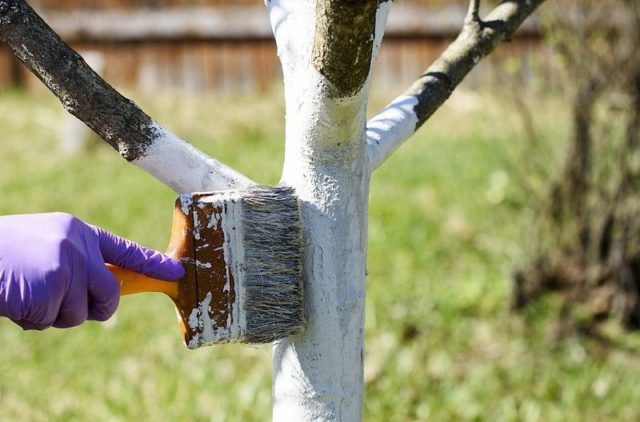
It is necessary to whitewash the trunk from pests and to protect against cold weather.
Preparing cherries for winter in autumn
After carrying out all the basic procedures, it is time to warm the cherry. It must be carried out before the arrival of frost, usually the tree is covered for the winter at the end of October or in the middle of November.
What kind of frost can a cherry withstand?
Cherry is considered a fairly winter-hardy fruit crop. The indicator of its frost resistance depends on the variety, but on average the tree is able to calmly tolerate frosts down to - 20-25 ° С. Certain varieties of cherries survive at temperatures below -35 ° C, which makes it possible to grow a crop even in Siberia.
How to insulate cherries for the winter
The algorithm for warming a cherry depends mainly on its age. It is customary to protect young trees from frost more thoroughly, while mature plants require minimal shelter.
A young
Preparing young cherries for winter consists of several stages:
- Before the onset of cold weather, the near-stem circle of plants is mulched with compost or humus. The layer of mulch should be about 10 cm, it will not only serve as a fertilizer for the cherry, but also protect its roots from freezing.
- In the photo of cherries in winter, you can see that young plants are tied with cardboard or light-colored non-woven material for the winter. This protects the trunk from frost and also prevents pests from damaging the tree.
After the first snowfalls, the trunk circle can also be insulated with a thick layer of snow. It will need to be scooped up to the cherry trunk, and sprinkled with straw or sawdust on top.
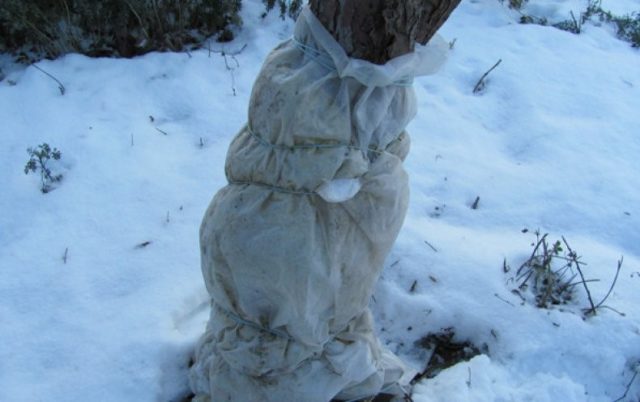
Young plants for the winter are additionally wrapped around the trunk
Old
Old tree cherries are more resistant to cold weather. Therefore, the trunk of a tree is usually not tied up and is limited to mulching the trunk circle. In this case, you need to ensure that the mulch layer does not touch the trunk of the fruit tree, otherwise the bark can support and rot. In cold winter conditions, the trunk of a fruit tree can be additionally overlaid with spruce branches.
Felt, columnar, bush
Certain varieties of cherries require a special approach to covering before winter:
- young felt cherry, like a tree-like one, it is customary to wrap it with white propylene bags, several layers of white paper or other light covering material for the winter, and also abundantly mulch the soil under the trunk;
- columnar cherry for the winter, they cover the top with a non-woven light material, pre-tying the shoots if necessary, and fix the shelter near the ground;
- bush cherry for the winter they tie it up so that heavy snow does not break its branches, and they also cover it with light insulating material and mulch the trunk circle.
In general, the measures to protect cherries from frost remain the same - it is necessary to protect the root system first. The trunk of the tree is insulated, if there is a convenient opportunity, for cherries with thin shoots, the integrity of the branches is monitored.
How to prepare cherries for winter in the regions
The preparation of a fruit tree for winter largely depends on the area of growth. The climate in the Moscow region, in the Urals and in Siberia is quite different, so the nuances of caring for the plant are also different.
Preparing cherries for winter in the Moscow region
Winter near Moscow is notable for its unpredictability, severe frosts can be replaced by sudden thaws. Despite the fact that the winter hardiness of most varieties of cherries allows you to leave the tree without winter shelter, it is still recommended to warm the culture for the winter.
Shortly before the onset of winter, the tree trunk circle is mulched with a layer of at least 10 cm, and the plant trunk is covered with spruce branches. In this case, the mulch must be positioned so that it does not touch the trunk, otherwise, during a thaw, the bark will underpin and rot.
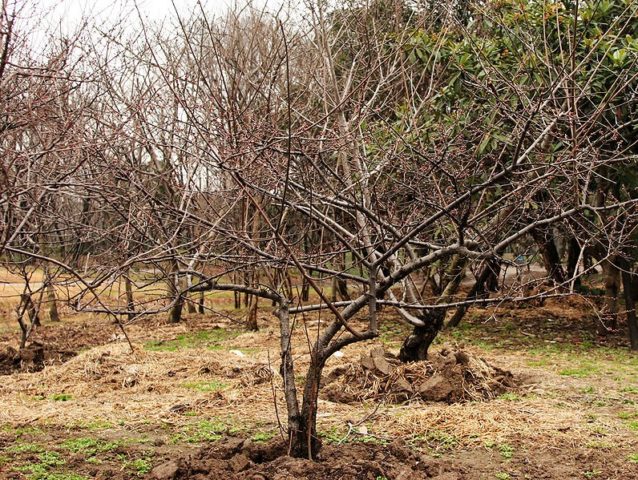
The layer of mulch for the winter should be at least 10 cm
Preparing cherries for winter in Siberia
Severe Siberian frosts pose a certain danger even for cold-resistant varieties. It is important to cover the plant well before winter. First of all, cherries are mulched under the trunk with a dense layer of compost or humus to prevent the roots from freezing. Caring for cherries in autumn in Siberia also includes insulating the trunk. In adult trees, it is covered with spruce branches, and young plants, columnar and bush cherries, if possible, are tied with insulating material.
In the middle lane and in the Urals
The Urals and central Russia are characterized by rather severe and snowy winters with strong winds. Therefore, the shelter also plays an important role, the cherry must not only be mulched under the trunk with a layer of 10 cm, but also cover the trunk and branches, if the size and structure of the tree allows this.
Since in the Urals, the wind and the bright winter sun pose a particular danger to cherries, it is initially better to plant a crop under the cover of buildings. In this case, the autumn-winter cherry care will become easier.

It is best to cover the plant before the cold weather in Siberia and the Urals.
Conclusion
Preparing cherries for winter includes several mandatory measures to preserve the health of the tree and its ability to bear fruit abundantly. It is necessary to start caring for cherries at the beginning of autumn, before the onset of cold weather, you need to have time to feed, cut and insulate the plant.
